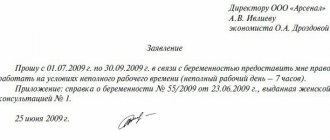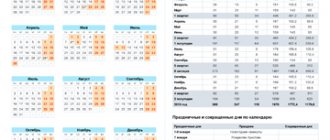Issues of recording time worked are always relevant - both for the employer and for the employee himself. Any person should know a few basic figures regarding his rights and responsibilities in the field of production. One of these indicators - perhaps one of the most important - can be considered the amount of working time that an employee is obliged to devote to the performance of official duties.
The working week in our country is 40 hours. According to the laws of the Russian Federation, this figure is decisive; the time norm for any week must fit into this amount. Based on it, the duration of day shifts is calculated. Since they must be equal in time to each other, there is one eight-hour shift for each of the five working days of the week.
How many working days should there be in a month?
But work schedules vary, which the employer informs the candidate about when hiring. All enterprises establish their own options based on production needs, but within the framework of current legislation.
The number of holidays determines how many working days there are in each month. Record holders in our country are January and May. We only have to work in them for about 17 - 18 working days. For comparison, in a typical month there are most often about 23 of them.
How to calculate how many working days are in 1 month? Subtract the number of weekends and holidays from 31 (or 30). The Labor Code regulates the maximum possible number of working days in each week. It is equal to 6.
That is, workers must be given at least one day off per week; working without any rest is prohibited.
Standard working time balance
The actual working time balance is compiled based on the following indicators:
- calendar fund - includes the number of days that are included in the period under consideration, usually a year;
- nominal period - all weekends and holidays are deducted from the calendar period;
- maximum - the due vacation is subtracted from the nominal indicator;
- attendance - those days when the employee did not show up for work are taken into account;
- actual - all downtime is also excluded.
Additionally, the standard balance of working time may include the following costs :
- downtime due to objective circumstances;
- emergencies;
- losses due to personal reasons on the part of employees.
The last point includes negligence, conversations with colleagues and on the phone, and solving personal problems. To identify them, it is necessary to take photographs of working hours . It will help determine the actual time required to perform duties. Based on the data obtained, deadlines and standards can be formed according to the production calendar.
Working time balance calculation
Planning and calculation of the working time balance is carried out taking into account the listed indicators. Their coefficients are often used for visual designation. To find them, calculate the ratio of the actual value to the standard value according to the calendar. The result obtained can also be converted into percentages.
For example, a quarter has 91 days. Of these, 25 days are weekends and three more are holidays. In total, you only need to work 63 days. This is a standard indicator.
Of these, the employee went to work only 59 shifts, that is, he had 4 absences. The coefficient will be their ratio to the norm, that is, 0.063, or 6.3%. Downtime and other losses are identified in the same way.
Working time balance includes the following aspects:
- periods during which the employee fulfilled his labor obligations;
- time that was not used for objective reasons;
- losses - the time that was not used by the employee to perform his duties.
There are several main stages in compiling this document. The whole process involves the following procedure :
- the predicted indicator is calculated according to the calendar, taking into account standard labor time, as well as data on vacations and other absences regulated by law;
- those periods of downtime expected from the employer are also taken into account, and the possible incapacity of the employee may also be taken into account;
- the average indicator is determined - the duration of the shift is multiplied by the standard days of work, after which the result is divided by the number of employees.
The ratio of the result obtained to the duration of the shift is a coefficient that determines the difference between the efficiency of the actual output of the calculated unit and the labor standard.
After drawing up the predicted standards according to the calendar and the actual ones, their provisions are compared. Based on the differences, the measures that need to be taken to improve labor efficiency are calculated.
Annual working time balance
The annual balance represents the forecast calendar year, during which all working days, weekends and holidays are calculated. This document contains the following indicators:
- regulated holidays;
- expected downtime;
- other possible causes of production losses.
Based on this standard, the main coefficients are calculated. However, they are calculated only after the end of the specified year and the preparation of the actual report.
Balance of working time of one worker
An average employee's time balance is a tool used by an employer to determine the performance of an individual employee. The calculation of the indicators used is carried out at the individual level.
As in the general case, an initially predicted balance is created according to the calendar, which is the regulatory framework. At the end of the billing period, a report is compiled with the actual values. Comparing two documents allows us to identify the productivity of an individual employee and opportunities to improve its efficiency.
If the employee is a minor
Article 51 of the Labor Code determines the norm for the duration of work shifts. Variations are possible in the form of a difference of several hours in its duration. This depends on the conditions of the specific production and the age of the employees.
What is meant by working age? A person has the right to get a job from the moment he turns 14 years old. But at this age there are restrictions on the length of working time during the week.
If the employee is under 16 years of age, it cannot be more than 24 hours. Children are allowed to work only during the holidays; their main job is to study.
Young people aged 16-18 have the right to work up to 36 hours weekly. And if we are talking about work during school hours (sometimes such exceptional circumstances occur), then minors are allowed even less - up to 12 hours at the age of 14-16 years and no more than 18 for those aged 16 to 18.
When are options still possible?
If production is officially considered hazardous, the law requires a reduction in working hours. Weekly it cannot exceed 36 hours. This figure is used to determine how many working days per month are required to be worked in such cases.
A number of professions, according to the specifics of their work, actually work in irregular hours. Therefore, officially their operating hours are somewhat shorter. This applies, for example, to doctors or teachers. How many working days they have on average per month is not so easy to calculate. Representatives of the mentioned professions are forced to seriously overwork part of the time during the year - doctors during periods of epidemics, teachers during exam days. There are other reasons that force teachers and doctors to devote more time to work than expected.

The administration of the enterprise can accommodate female workers - mothers of children under 14 years of age and officially approve a shortened week for them. Benefits are also provided to caregivers of disabled children.
Basic legal requirements
The Labor Code of the Russian Federation states that the working day should not exceed forty hours per week. Thus, the duration of a shift is usually divided into eight working hours. This is due to the fact that you should work five days a week, and the number of hours in each shift should be the same. Focusing on the specifics of the schedule, which is discussed at the interview stage, you can know how many hours you need to work each working day.
At the same time, the month also turns out to be truly important, because the features of the work process depend on the number of holidays - in January-May, long holidays reduce the number of working days to 17-18, and the standard number of working days in most months (with the exception of January, February, May) is 22 -23 (subtracted from 30-31).
How many days might the longest workflow represent? You are allowed to work no more than six days a week. Thus, one regular day off is mandatory.
Work shift duration
Article 94 of the Labor Code of the Russian Federation states that the duration of the work shift may vary. The number of hours that must be worked per day varies depending on the employee’s age category and working conditions. What aspects need to be noted in terms of hours to be worked? How many hours must an employee work and how can one gain confidence that the quota set for the month has been met?
Workers between the ages of fourteen and sixteen can work no more than 25 hours a week and only during their own holidays; those aged sixteen to eighteen can work 35 hours a week. In this case, the duration of working hours of a student who seeks to work during the academic year in his free time should not exceed half of the established maximum duration of the work shift provided for in the first paragraph of the paragraph for persons of a certain age category.
A shortened shift becomes effective for workers who must face hazardous working conditions. In this case, you can work up to 36 hours per week, which means a decrease of 4 hours per week, but this reduction will not be noted per day. In addition, a reduced duration is established for individual specialists , among whom it should be noted doctors, teachers, whose schedule also depends on what the period will be for students or schoolchildren, because there are exam weeks, which creates additional complexity, and doctors are forced to work more hours in periods of epidemics.
Enterprise administrators can reduce work shifts for women who have children under the age of 14 or are mothers of disabled people, focusing on the optimal number of hours for work and compliance with Russian legislation.
Thus, you should know how many working hours there are in a month, focusing on the numerous features of the Labor Code of the Russian Federation.
Work schedule during holiday periods
In part one of Article 112 of the Labor Code of the Russian Federation, non-working holidays:
- From the first to the eighth of January - New Year holidays, and on the seventh of January - Christmas.
- The twenty-third of February is Defender of the Fatherland Day.
- The eighth of March is International Women's Day.
- The first of May is the Holiday of Spring and Labor.
- The ninth of May is Victory Day.
- The twelfth of June is Russia Day.
- The fourth of November is National Unity Day.
It is important to remember that if a day off coincides with a holiday that is a non-working day, it is customary to move the day off to the next working day after the holiday. The exception is the New Year holidays. This information is specified in the second part of Article 112 of the Labor Code of the Russian Federation. Based on the above indicators, it can be understood that the largest number of holidays occurs in January, and in some years - in May, as transfers occur by day.

We take into account holidays and weekends
Data on how many working days there are in a month, as well as the number of hours, is the basis for accounting operations. Article 112 of the Labor Code lists the days officially called holidays, i.e. non-working days. These are January 1-8, February 23, March 8, May 1, May 9, June 12, November 4.
If any of the listed dates coincides with a Sunday, the day immediately following it is declared an additional day off. This provision does not apply to the New Year holidays.
Salaries are calculated based on the number of days worked per month. This indicator (how many working days in a month on average), depending on the ratio of working days and weekends (including holidays), is used as a guide when calculating the amount of material remuneration. Such data is used, among other things, in statistics and analytics.
Production calendar for 2021
The calendar for May, including weekends in May, looks like this (weekends in May 2021 are in italics).
| Mon | VT | SR | Thu | PT | SB | Sun |
| 1 | 2 | |||||
| 3 | 4 | 5 | 6 | 7 | 8 | 9 |
| 10 | 11 | 12 | 13 | 14 | 15 | 16 |
| 17 | 18 | 19 | 20 | 21 | 22 | 23 |
| 24 | 25 | 26 | 27 | 28 | 29 | 30 |
| 31 |
Number of calendar days for 2021 - 365 working days - 247 weekends/holidays - 118
Working hours for 2021 (in hours) for a 40-hour week - 1,972.00 for a 36-hour week - 1,774.40 for a 24-hour week - 1,181.60
* Pre-holiday days, on which work hours are reduced by one hour.
| Mon | W | Wed | Thu | Fri | Sat | Sun | |
| 53 | 1 | 2 | 3 | ||||
| 1 | 4 | 5 | 6 | 7 | 8 | 9 | 10 |
| 2 | 11 | 12 | 13 | 14 | 15 | 16 | 17 |
| 3 | 18 | 19 | 20 | 21 | 22 | 23 | 24 |
| 4 | 25 | 26 | 27 | 28 | 29 | 30 | 31 |
| Calendar days | 31 |
| Working days | 15 |
| Weekends/holidays | 16 |
| 40 hour week | 120 hours |
| Mon | W | Wed | Thu | Fri | Sat | Sun | |
| 5 | 1 | 2 | 3 | 4 | 5 | 6 | 7 |
| 6 | 8 | 9 | 10 | 11 | 12 | 13 | 14 |
| 7 | 15 | 16 | 17 | 18 | 19 | 20 | 21 |
| 8 | 22 | 23 | 24 | 25 | 26 | 27 | 28 |
| 9 |
| Calendar days | 28 |
| Working days | 19 |
| Weekends/holidays | 9 |
| 40 hour week | 151 hours |
| Mon | W | Wed | Thu | Fri | Sat | Sun | |
| 17 | 1 | 2 | |||||
| 18 | 3 | 4 | 5 | 6 | 7 | 8 | 9 |
| 19 | 10 | 11 | 12 | 13 | 14 | 15 | 16 |
| 20 | 17 | 18 | 19 | 20 | 21 | 22 | 23 |
| 21 | 24 | 25 | 26 | 27 | 28 | 29 | 30 |
| 22 | 31 |
| Calendar days | 31 |
| Working days | 19 |
| Weekends/holidays | 12 |
| 40 hour week | 151 hours |
| Mon | W | Wed | Thu | Fri | Sat | Sun | |
| 26 | 1 | 2 | 3 | 4 | |||
| 27 | 5 | 6 | 7 | 8 | 9 | 10 | 11 |
| 28 | 12 | 13 | 14 | 15 | 16 | 17 | 18 |
| 29 | 19 | 20 | 21 | 22 | 23 | 24 | 25 |
| 30 | 26 | 27 | 28 | 29 | 30 | 31 |
| Calendar days | 31 |
| Working days | 22 |
| Weekends/holidays | 9 |
| 40 hour week | 176 hours |
| Mon | W | Wed | Thu | Fri | Sat | Sun | |
| 30 | 1 | ||||||
| 31 | 2 | 3 | 4 | 5 | 6 | 7 | 8 |
| 32 | 9 | 10 | 11 | 12 | 13 | 14 | 15 |
| 33 | 16 | 17 | 18 | 19 | 20 | 21 | 22 |
| 34 | 23 | 24 | 25 | 26 | 27 | 28 | 29 |
| 35 | 30 | 31 |
| Calendar days | 31 |
| Working days | 22 |
| Weekends/holidays | 9 |
| 40 hour week | 176 hours |
| Mon | W | Wed | Thu | Fri | Sat | Sun | |
| 39 | 1 | 2 | 3 | ||||
| 40 | 4 | 5 | 6 | 7 | 8 | 9 | 10 |
| 41 | 11 | 12 | 13 | 14 | 15 | 16 | 17 |
| 42 | 18 | 19 | 20 | 21 | 22 | 23 | 24 |
| 43 | 25 | 26 | 27 | 28 | 29 | 30 | 31 |
| Calendar days | 31 |
| Working days | 21 |
| Weekends/holidays | 10 |
| 40 hour week | 168 hours |
1. For a 5-day work week
| Months and other periods of the year | Amount of days | Estimated standard working hours (in hours) | |||
| calendar | workers (regular and pre-holiday) | non-working (weekends and holidays) | with a 40 hour work week | with a 35 hour work week | |
| January | 31 | 19 (18 + 1) | 12 (9 + 3) | 151 | 132 |
| February | 28 | 20 | 8 | 160 | 140 |
| March | 31 | 22 | 9 (8 + 1) | 176 | 154 |
| I quarter | 90 | 61 | 29 | 487 | 426 |
| April | 30 | 22 (21 + 1) | 8 | 175 | 153 |
| May | 31 | 20 (19 + 1) | 11 (8 + 3) | 159 | 139 |
| June | 30 | 22 | 8 | 176 | 154 |
| II quarter | 91 | 64 | 27 | 510 | 446 |
| 1st half of the year | 181 | 125 | 56 | 997 | 872 |
| July | 31 | 22 (21 + 1) | 9 (8 + 1) | 175 | 153 |
| August | 31 | 22 | 9 | 176 | 154 |
| September | 30 | 22 | 8 | 176 | 154 |
| III quarter | |||||
What is a man-day
The basic unit for recording working time is the man-day. It is considered worked in the event of a conscientious attendance at work and full performance of official duties. At the same time, we are not talking about the quality of work - only about its quantitative side.
Man-days are considered worked even if the employee is on business trips (if this is provided for by his job responsibilities). The same applies to situations where an employee, on behalf of his superiors, works on the territory of another company.

Working time calendar for 2021 with holidays and weekends
To calculate the projected balance, a production calendar approved by law is used. This document takes into account all holidays and weekends approved for the current year.
This standard is mandatory for government agencies. It takes into account a five-day work week and various production standards. According to these data, normalized values are established for calculating the balance.
For other organizations, the calculation of days off may differ from the proposed one. In this case, the calendar for the year is drawn up as an internal local act. He must take into account the prescribed work rate, which does not exceed 40 hours per week.
Reasons for absences - good and not so
In case of absenteeism or actual failure to perform work duties, this day is not counted as worked, but is equated to downtime. Accounting for how many working days a particular employee has in a month is made in the form of a special report card, where each day is marked by attendance or non-appearance.
The main reasons for absences are different types of leave (annual, educational - for part-time students to take exams, without pay, etc.). In addition - absence due to illness, performance of certain public duties. Unexcused reasons for absences include absenteeism.
Not just a five-day week
The Labor Code allows the employer to establish, if necessary, a shift work schedule. Objective prerequisites for this can be a production cycle longer than the daily working hours required by law and the optimal use of working capacity. An example would be a conveyor line operating in a continuous cycle.
These types of work require a different - shift schedule. It is assumed that several groups of workers will be occupied in turn servicing the production cycle, each within the standard working hours. How many working days each month has depends on the specific schedule adopted.
Norm hours for shift schedules
Due to the specific nature of production, many employers find it difficult, and sometimes impossible, to fit a shift schedule into the normal length of the working week (40 hours). In this case, a summary option for recording time worked is provided.
The base (accounting) period is a month, quarter or year. The total time an employee spends performing production duties for the entire accounting period should not exceed the number of standard hours that is a multiple of the number of working weeks. The accounting period cannot be longer than one year.
Knowing the standard hours, you can easily calculate, for example, how many working days there are in 9 months (or for another period).
The schedule called “in three days” raises many questions. Some consider it shiftable (after all, workers replace each other in the same place). In fact, the change does not occur within a day - we are talking about longer periods. And such a schedule would be more correctly called a flexible work schedule.
Working hours are recorded here over an extended period. The total number of hours worked during the year corresponds to the norm.








